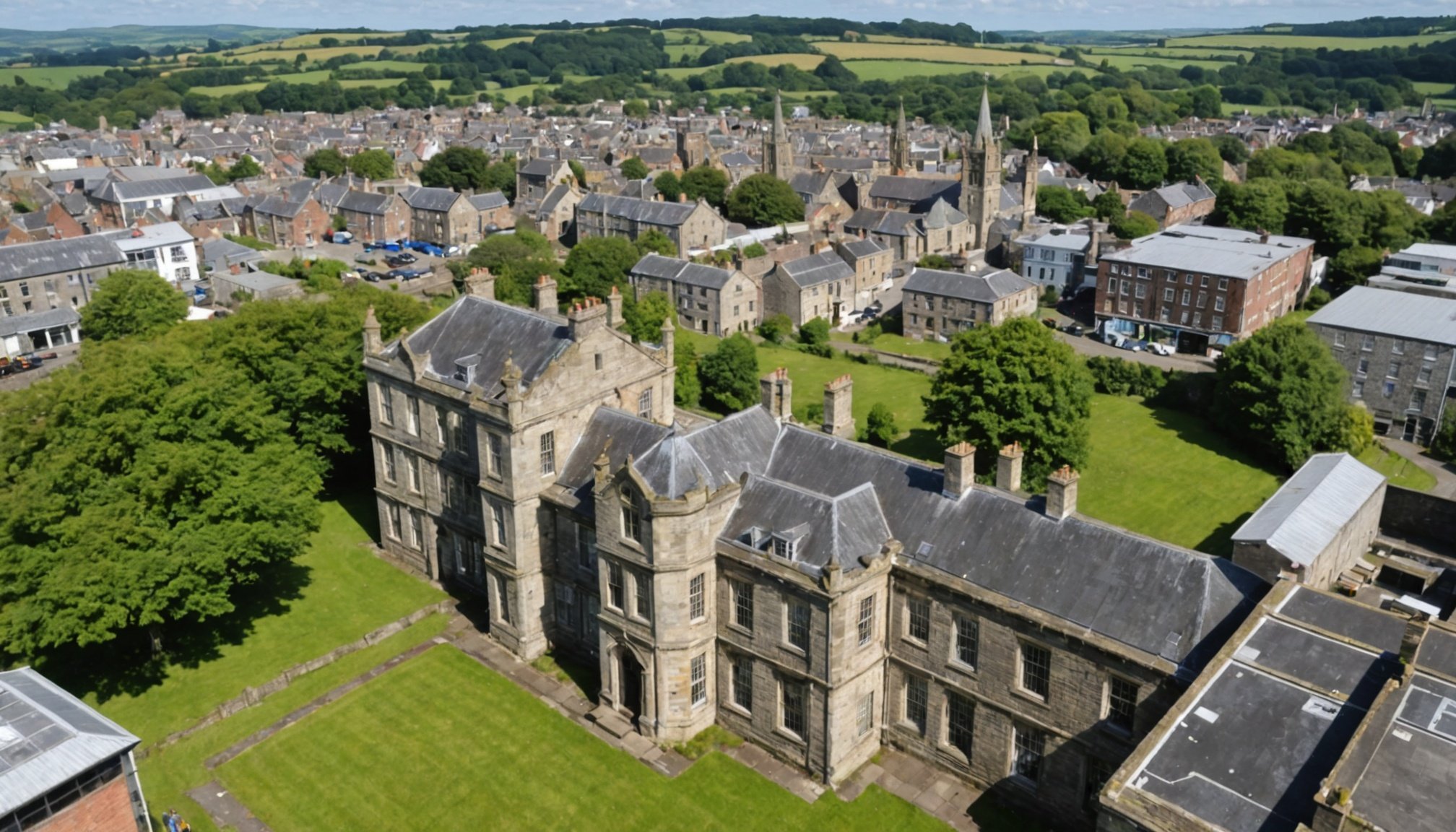Revitalizing derelict buildings in Wales presents an exciting opportunity for developers. Securing grants can significantly ease the financial strain of such projects. This guide reveals essential tips and resources for unlocking funding opportunities specifically designed for the refurbishment of abandoned structures. Discover how to navigate the application process, tailor your proposals, and increase your chances of success, enabling you to transform these neglected spaces into vibrant community assets. Embrace the potential for change and investment in Wales' architectural heritage.
Overview of Funding Opportunities for Derelict Buildings in Wales
Exploring the financial avenues for transforming derelict properties can be a game-changer for developers.
A découvrir également : Unlocking Your Property's Potential With 3D Virtual Tours
Types of Funding Available for Developers
In Wales, there is a diverse array of funding opportunities aimed at the revitalization of derelict buildings. These options include government grants, private investments, and public-private partnerships. Developers can tap into these resources to offset the costs associated with renovation and construction. For instance, the Welsh Government offers specific grants that encourage the transformation of abandoned properties into viable community spaces. Non-governmental organizations also play a pivotal role by providing financial support and expertise to ensure projects are sustainable and beneficial to the community.
Importance of Revitalizing Derelict Buildings
Revitalizing derelict buildings is crucial not only for aesthetic reasons but also for economic and social benefits. These projects can breathe new life into communities, offering new housing, business opportunities, and public spaces. As one expert noted, "The revitalization of derelict buildings is not just about restoration; it's about transformation and creating vibrant communities." By investing in such projects, developers contribute to the reduction of urban decay and the promotion of economic growth.
A lire en complément : Can non-residents obtain a mortgage for a property in Northern Ireland?
Overview of Governmental and Non-Governmental Support
Both governmental and non-governmental entities offer substantial support for the revitalization of derelict buildings. The Welsh Government provides various programs that focus on urban regeneration, often covering a significant portion of the renovation costs. On the non-governmental side, organizations might offer technical assistance and funding to ensure projects align with community needs. Below is a simplified table illustrating some of the available support:
| Type of Support | Provider | Focus |
|---|---|---|
| Grants | Welsh Government | Urban Regeneration |
| Technical Assistance | Non-Governmental Orgs | Community Development |
| Public-Private Funding | Partnerships | Sustainable Projects |
These funding opportunities are essential for developers looking to make a substantial impact through the revitalization of derelict buildings, ultimately fostering a more vibrant and economically stable Wales.
Available Grants for Property Renovation
Exploring the various grants available for property renovation can greatly assist developers in transforming derelict buildings into thriving spaces.
Government Grants
Government grants offer substantial financial support for property renovation projects. These grants are designed to encourage the revitalization of derelict properties, providing developers with the necessary resources to undertake large-scale renovations. Eligibility criteria often include factors such as the property's location, historical significance, and the intended use post-renovation. The application process typically involves submitting detailed proposals outlining the project's scope, budget, and expected community impact. As one government official stated, "Our goal is to support projects that not only restore buildings but also enhance community life."
Charitable Trusts and Foundations
Charitable trusts and foundations also play a crucial role in providing financial support for property renovation. These organizations often focus on projects that align with their mission of community development and sustainability. The application procedures for these grants may vary, but they generally require a demonstration of how the project will benefit the local community. Successful funding examples include transforming old factories into community centers or affordable housing.
European Union Funding Opportunities
European Union funding opportunities present another avenue for securing financial support. These grants are part of broader EU initiatives aimed at regional development and revitalization. Eligibility for EU funding typically requires compliance with specific guidelines, including sustainable practices and cross-border collaboration. The application process can be complex, but the potential benefits are significant, offering developers the chance to access substantial resources for their renovation projects.
- Types of Grants Available:
- Government Grants
- Charitable Trusts
- EU Funding
Understanding these various grants and their requirements is essential for developers seeking to leverage financial support effectively in their property renovation endeavors.
Application Process for Securing Grants
Navigating the application process for securing grants can be a daunting task, but understanding the steps involved can significantly enhance your chances of success.
Step-by-Step Guide to Grant Applications
Successfully securing funding applications begins with a thorough understanding of the specific requirements outlined by the grant provider. Start by carefully reviewing the eligibility criteria and ensure your project aligns with the grant's objectives. Prepare a detailed grant proposal that clearly articulates your project's goals, budget, and expected community impact. It is crucial to follow the application guidelines meticulously, as deviations can lead to disqualification.
Common Pitfalls to Avoid in Proposals
Many developers encounter challenges during the application process due to common pitfalls. One frequent mistake is submitting incomplete or inaccurate information. Ensure all sections of the grant proposal are filled out correctly and supported by relevant data. Additionally, avoid using technical jargon that may confuse evaluators; clarity and simplicity are key. As one seasoned grant writer suggests, "A well-organized and straightforward proposal speaks volumes."
Tips for Creating Compelling Grant Proposals
Crafting a compelling grant proposal requires attention to detail and a persuasive narrative. Highlight the unique aspects of your project and its potential benefits to the community. Use a bulleted list to succinctly present key points:
- Clearly define the project objectives
- Provide a realistic budget breakdown
- Demonstrate community support and involvement
- Highlight past successes or experience
By following these tips and avoiding common pitfalls, you can enhance the effectiveness of your funding applications and increase the likelihood of securing the necessary grants for your project.
Eligibility Criteria for Grant Applications
Understanding the eligibility criteria for grant applications is essential for developers aiming to secure funding for their projects.
General Eligibility Criteria
Before diving into specific grants, it is crucial to comprehend the general eligibility criteria that most funding bodies require. These typically include the project's alignment with the grant's objectives, the potential community impact, and the sustainability of the proposed project. Developers should ensure their projects meet these fundamental qualifications to increase their chances of success. As one expert advises, "Aligning your project goals with the funder's mission is the first step towards eligibility."
Specific Requirements for Different Grants
Different grants come with unique funding requirements that applicants must adhere to. For instance, government grants may prioritize projects in certain geographic areas or those that offer significant economic benefits. Charitable trusts might focus on community development and sustainable practices, while EU funding opportunities often require cross-border collaboration. Understanding these specific requirements is vital for tailoring applications to meet the grant qualifications.
Recommendations for Meeting Eligibility
To enhance your project's eligibility, consider the following recommendations:
- Thoroughly review the eligibility criteria for each grant.
- Align your project with the specific objectives of the funding body.
- Demonstrate clear community benefits and sustainability.
- Provide evidence of past successes or relevant experience.
By following these recommendations, developers can improve their chances of meeting the eligibility criteria and successfully securing the necessary funding for their projects.
Best Practices for Proposal Writing
Crafting a compelling proposal requires attention to detail and strategic planning.
Key Components of a Successful Proposal
A well-structured proposal is essential for securing grant funding. Key components include a clear statement of objectives, a comprehensive budget, and a detailed timeline. Each section should be meticulously crafted to align with the funder's priorities. For instance, the proposal should clearly outline how the project addresses specific community needs and contributes to sustainable development.
Importance of Research and Data in Proposals
Incorporating thorough research and reliable data strengthens a proposal significantly. Funders are more likely to support projects backed by evidence and thorough analysis. Use data to demonstrate the project's potential impact and feasibility. For example, including statistics on local economic benefits or environmental improvements can make a compelling case for grant applications.
Tailoring Proposals to Funder Priorities
Tailoring your proposal to align with the funder's objectives is crucial. Each grant application should be customized to reflect the specific goals and interests of the funding body. This might involve emphasizing certain aspects of the project or adjusting the narrative to better resonate with the funder's mission. As one expert notes, "Understanding the funder's priorities is half the battle in successful proposal writing."
- Key Proposal Components:
- Clear objectives
- Comprehensive budget
- Detailed timeline
By focusing on these best practices, developers can enhance their grant applications and increase their chances of securing the necessary funding.
Networking with Local Authorities and Organizations
Building strong relationships with local councils and community organizations is crucial for developers aiming to secure funding and support for revitalization projects. Engaging with these entities can provide invaluable insights and resources, facilitating smoother project execution and greater community impact.
Importance of Building Relationships with Local Councils
Establishing connections with local councils is essential as they often have significant influence over regional development projects. These relationships can lead to early access to information about upcoming funding opportunities and policy changes. By collaborating with councils, developers can ensure their projects align with local priorities, increasing the likelihood of gaining approval and support. As one council member noted, "Effective networking with local authorities opens doors to resources and partnerships that are otherwise inaccessible."
Engaging Community Organizations for Support
Community organizations play a pivotal role in the success of revitalization projects. They provide grassroots support and can help developers understand the specific needs and desires of the community. Engaging these organizations early in the project can lead to more tailored and impactful outcomes. Developers should prioritize networking with key community leaders and groups to foster trust and collaboration. This approach not only enhances project credibility but also ensures that the benefits are widely felt.
Strategies for Effective Networking
Effective networking requires a strategic approach. Developers should actively participate in local events and forums to build visibility and connections. Here are some strategies to consider:
- Attend community meetings to stay informed and engaged.
- Collaborate on joint initiatives to build trust and mutual goals.
- Leverage social media to maintain ongoing communication with stakeholders.
By implementing these strategies, developers can strengthen their relationships with local authorities and organizations, ultimately enhancing the success and sustainability of their projects.
Legal Considerations in Revitalization Projects
Navigating the legal considerations in revitalization projects is crucial for ensuring compliance and success.
Planning Permissions and Regulations
Understanding the planning permissions and regulations is fundamental in any revitalization project. Developers must secure the necessary approvals from local authorities to proceed with construction and renovation. These permissions ensure that the project aligns with regional development plans and zoning laws. As one legal expert highlights, "Securing planning permissions early can prevent costly delays and legal challenges."
Environmental Assessments
Conducting thorough environmental assessments is a key legal requirement in revitalization efforts. These assessments evaluate the potential impact of the project on the surrounding environment and ensure compliance with environmental laws. Developers are often required to submit detailed reports demonstrating how they will mitigate any adverse effects. Failure to comply can result in significant penalties and project delays.
Health and Safety Compliance
Ensuring health and safety compliance is a non-negotiable aspect of any revitalization project. Developers must adhere to strict safety standards to protect workers and the public. This involves implementing safety protocols and regular inspections. Non-compliance can lead to severe legal consequences and jeopardize the project's success.
- Key Legal Considerations:
- Securing planning permissions
- Conducting environmental assessments
- Ensuring health and safety compliance
By prioritizing these legal aspects, developers can navigate the complexities of property law and enhance the sustainability of their projects.
Case Studies of Successful Revitalization Projects in Wales
Exploring real-life examples of successful revitalization projects provides valuable insights into effective strategies and outcomes.
Notable Projects and Their Funding Sources
Several successful projects in Wales demonstrate the transformative power of strategic funding and community engagement. The redevelopment of the historic Coal Exchange in Cardiff is a prime example. This project, funded through a combination of government grants and private investments, turned a derelict building into a vibrant hotel and event space. Another noteworthy example is the restoration of the Pontio Arts and Innovation Centre in Bangor, which utilized public-private partnerships to create a multifunctional cultural hub. These case studies highlight the importance of diverse funding sources in achieving project goals.
Lessons Learned from Successful Revitalization Efforts
From these revitalization examples, several key lessons emerge. First, effective project management and community involvement are crucial. Engaging local stakeholders early in the process ensures that projects meet community needs and gain necessary support. Additionally, leveraging multiple funding sources can mitigate financial risks and enhance project viability. As one project manager noted, "Collaborating with various funders not only diversifies financial backing but also brings different expertise to the table."
Impact on Local Communities
The impact of these successful projects extends beyond physical transformation. They contribute to economic growth, social cohesion, and cultural enrichment. For instance, the Coal Exchange's revival has boosted tourism and created jobs, while the Pontio Centre has become a focal point for community events and innovation. The table below summarizes the outcomes of these revitalization examples:
| Project | Funding Sources | Community Impact |
|---|---|---|
| Coal Exchange | Government grants, private | Increased tourism, jobs |
| Pontio Centre | Public-private partnerships | Cultural hub, innovation |
These case studies underscore the potential of revitalization projects to drive positive change in local communities, offering a blueprint for future endeavors.











